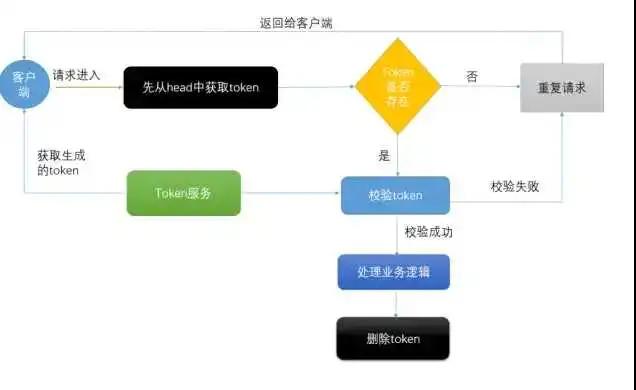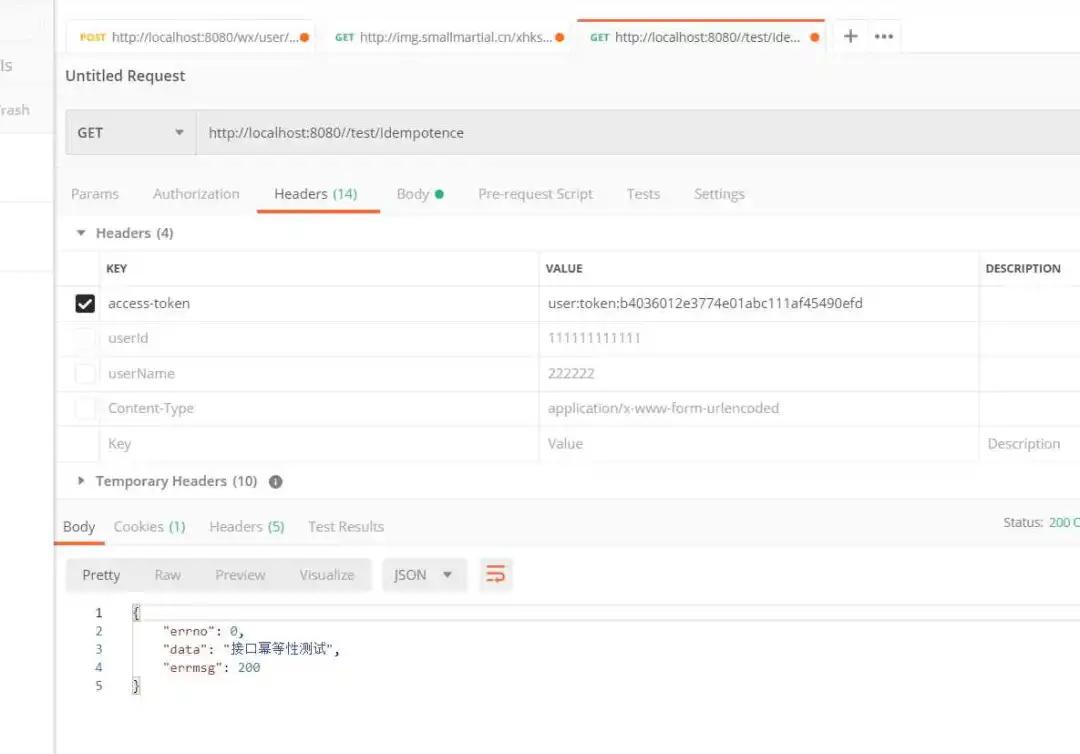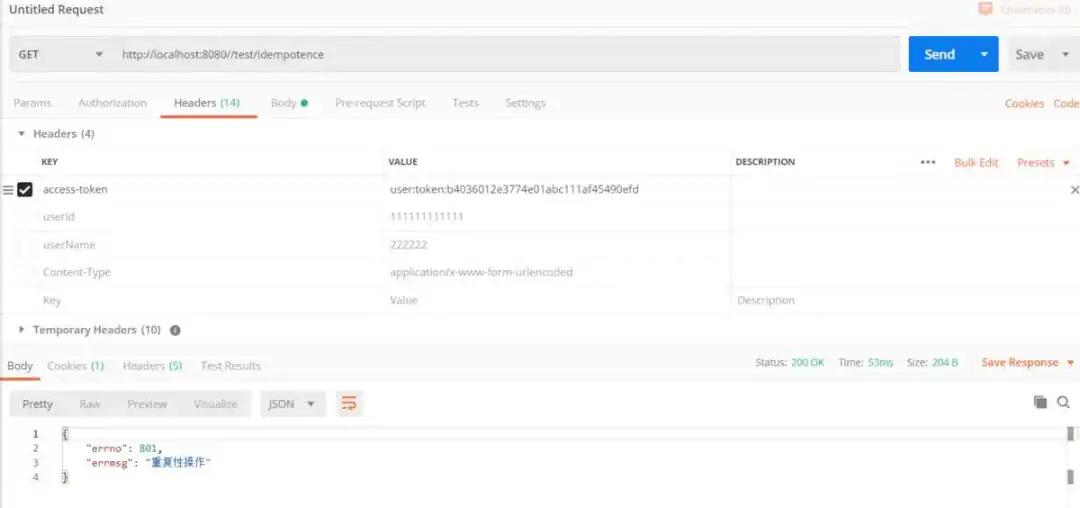本文转载自微信公众号「小明菜市场」,可以通过以下二维码关注。转载本文请联系小明菜市场公众号。
介绍
幂等性的概念是,任意多次执行所产生的影响都与一次执行产生的影响相同,按照这个含义,最终的解释是对数据库的影响只能是一次性的,不能重复处理。手段如下
- 数据库建立唯一索引
- token机制
- 悲观锁或者是乐观锁
- 先查询后判断
小小主要带你们介绍Redis实现自动幂等性。其原理如下图所示。
实现过程
引入 maven 依赖
- <dependency>
- <groupId>org.springframework.boot</groupId>
- <artifactId>spring-boot-starter-data-redis</artifactId>
- </dependency>
spring 配置文件写入
- server.port=8080
- core.datasource.druid.enabled=true
- core.datasource.druid.url=jdbc:mysql://192.168.1.225:3306/?useUnicode=true&characterEncoding=UTF-8
- core.datasource.druid.username=root
- core.datasource.druid.password=
- core.redis.enabled=true
- spring.redis.host=192.168.1.225 #本机的redis地址
- spring.redis.port=16379
- spring.redis.database=3
- spring.redis.jedis.pool.max-active=10
- spring.redis.jedis.pool.max-idle=10
- spring.redis.jedis.pool.max-wait=5s
- spring.redis.jedis.pool.min-idle=10
引入 Redis
引入 Spring boot 中的redis相关的stater,后面需要用到 Spring Boot 封装好的 RedisTemplate
- package cn.smallmartial.demo.utils;
- import org.springframework.beans.factory.annotation.Autowired;
- import org.springframework.data.redis.core.RedisTemplate;
- import org.springframework.data.redis.core.ValueOperations;
- import org.springframework.stereotype.Component;
- import java.io.Serializable;
- import java.util.Objects;
- import java.util.concurrent.TimeUnit;
- /**
- * @Author smallmartial
- * @Date 2020/4/16
- * @Email smallmarital@qq.com
- */
- @Component
- public class RedisUtil {
- @Autowired
- private RedisTemplate redisTemplate;
- /**
- * 写入缓存
- *
- * @param key
- * @param value
- * @return
- */
- public boolean set(final String key, Object value) {
- boolean result = false;
- try {
- ValueOperations<Serializable, Object> operations = redisTemplate.opsForValue();
- operations.set(key, value);
- result = true;
- } catch (Exception e) {
- e.printStackTrace();
- }
- return result;
- }
- /**
- * 写入缓存设置时间
- *
- * @param key
- * @param value
- * @param expireTime
- * @return
- */
- public boolean setEx(final String key, Object value, long expireTime) {
- boolean result = false;
- try {
- ValueOperations<Serializable, Object> operations = redisTemplate.opsForValue();
- operations.set(key, value);
- redisTemplate.expire(key, expireTime, TimeUnit.SECONDS);
- result = true;
- } catch (Exception e) {
- e.printStackTrace();
- }
- return result;
- }
- /**
- * 读取缓存
- *
- * @param key
- * @return
- */
- public Object get(final String key) {
- Object result = null;
- ValueOperations<Serializable, Object> operations = redisTemplate.opsForValue();
- result = operations.get(key);
- return result;
- }
- /**
- * 删除对应的value
- *
- * @param key
- */
- public boolean remove(final String key) {
- if (exists(key)) {
- Boolean delete = redisTemplate.delete(key);
- return delete;
- }
- return false;
- }
- /**
- * 判断key是否存在
- *
- * @param key
- * @return
- */
- public boolean exists(final String key) {
- boolean result = false;
- ValueOperations<Serializable, Object> operations = redisTemplate.opsForValue();
- if (Objects.nonNull(operations.get(key))) {
- result = true;
- }
- return result;
- }
- }
自定义注解
自定义一个注解,定义此注解的目的是把它添加到需要实现幂等的方法上,只要某个方法注解了其,都会自动实现幂等操作。其代码如下
- @Target({ElementType.METHOD})
- @Retention(RetentionPolicy.RUNTIME)
- public @interface AutoIdempotent {
- }
token 的创建和实现
token 服务接口,我们新建一个接口,创建token服务,里面主要是有两个方法,一个用来创建 token,一个用来验证token
- public interface TokenService {
- /**
- * 创建token
- * @return
- */
- public String createToken();
- /**
- * 检验token
- * @param request
- * @return
- */
- public boolean checkToken(HttpServletRequest request) throws Exception;
- }
token 的实现类,token中引用了服务的实现类,token引用了 redis 服务,创建token采用随机算法工具类生成随机 uuid 字符串,然后放入 redis 中,如果放入成功,返回token,校验方法就是从 header 中获取 token 的值,如果不存在,直接跑出异常,这个异常信息可以被直接拦截到,返回给前端。
- package cn.smallmartial.demo.service.impl;
- import cn.smallmartial.demo.bean.RedisKeyPrefix;
- import cn.smallmartial.demo.bean.ResponseCode;
- import cn.smallmartial.demo.exception.ApiResult;
- import cn.smallmartial.demo.exception.BusinessException;
- import cn.smallmartial.demo.service.TokenService;
- import cn.smallmartial.demo.utils.RedisUtil;
- import io.netty.util.internal.StringUtil;
- import org.springframework.beans.factory.annotation.Autowired;
- import org.springframework.stereotype.Service;
- import org.springframework.util.StringUtils;
- import javax.servlet.http.HttpServletRequest;
- import java.util.Random;
- import java.util.UUID;
- /**
- * @Author smallmartial
- * @Date 2020/4/16
- * @Email smallmarital@qq.com
- */
- @Service
- public class TokenServiceImpl implements TokenService {
- @Autowired
- private RedisUtil redisService;
- /**
- * 创建token
- *
- * @return
- */
- @Override
- public String createToken() {
- String str = UUID.randomUUID().toString().replace("-", "");
- StringBuilder token = new StringBuilder();
- try {
- token.append(RedisKeyPrefix.TOKEN_PREFIX).append(str);
- redisService.setEx(token.toString(), token.toString(), 10000L);
- boolean empty = StringUtils.isEmpty(token.toString());
- if (!empty) {
- return token.toString();
- }
- } catch (Exception ex) {
- ex.printStackTrace();
- }
- return null;
- }
- /**
- * 检验token
- *
- * @param request
- * @return
- */
- @Override
- public boolean checkToken(HttpServletRequest request) throws Exception {
- String token = request.getHeader(RedisKeyPrefix.TOKEN_NAME);
- if (StringUtils.isEmpty(token)) {// header中不存在token
- token = request.getParameter(RedisKeyPrefix.TOKEN_NAME);
- if (StringUtils.isEmpty(token)) {// parameter中也不存在token
- throw new BusinessException(ApiResult.BADARGUMENT);
- }
- }
- if (!redisService.exists(token)) {
- throw new BusinessException(ApiResult.REPETITIVE_OPERATION);
- }
- boolean remove = redisService.remove(token);
- if (!remove) {
- throw new BusinessException(ApiResult.REPETITIVE_OPERATION);
- }
- return true;
- }
- }
拦截器的配置
用于拦截前端的 token,判断前端的 token 是否有效
- @Configuration
- public class WebMvcConfiguration extends WebMvcConfigurationSupport {
- @Bean
- public AuthInterceptor authInterceptor() {
- return new AuthInterceptor();
- }
- /**
- * 拦截器配置
- *
- * @param registry
- */
- @Override
- public void addInterceptors(InterceptorRegistry registry) {
- registry.addInterceptor(authInterceptor());
- // .addPathPatterns("/ksb/**")
- // .excludePathPatterns("/ksb/auth/**", "/api/common/**", "/error", "/api/*");
- super.addInterceptors(registry);
- }
- @Override
- public void addResourceHandlers(ResourceHandlerRegistry registry) {
- registry.addResourceHandler("/**").addResourceLocations(
- "classpath:/static/");
- registry.addResourceHandler("swagger-ui.html").addResourceLocations(
- "classpath:/META-INF/resources/");
- registry.addResourceHandler("/webjars/**").addResourceLocations(
- "classpath:/META-INF/resources/webjars/");
- super.addResourceHandlers(registry);
- }
- }
拦截处理器:主要用于拦截扫描到 Autoldempotent 到注解方法,然后调用 tokenService 的 checkToken 方法校验 token 是否正确,如果捕捉到异常就把异常信息渲染成 json 返回给前端。这部分代码主要和自定义注解部分挂钩。其主要代码如下所示
- @Slf4j
- public class AuthInterceptor extends HandlerInterceptorAdapter {
- @Autowired
- private TokenService tokenService;
- @Override
- public boolean preHandle(HttpServletRequest request, HttpServletResponse response, Object handler) throws Exception {
- if (!(handler instanceof HandlerMethod)) {
- return true;
- }
- HandlerMethod handlerMethod = (HandlerMethod) handler;
- Method method = handlerMethod.getMethod();
- //被ApiIdempotment标记的扫描
- AutoIdempotent methodAnnotation = method.getAnnotation(AutoIdempotent.class);
- if (methodAnnotation != null) {
- try {
- return tokenService.checkToken(request);// 幂等性校验, 校验通过则放行, 校验失败则抛出异常, 并通过统一异常处理返回友好提示
- } catch (Exception ex) {
- throw new BusinessException(ApiResult.REPETITIVE_OPERATION);
- }
- }
- return true;
- }
- }
测试用例
这里进行相关的测试用例 模拟业务请求类,通过相关的路径获得相关的token,然后调用 testidempotence 方法,这个方法注解了 @Autoldempotent,拦截器会拦截所有的请求,当判断到处理的方法上面有该注解的时候,就会调用 TokenService 中的 checkToken() 方法,如果有异常会跑出,代码如下所示
- /**
- * @Author smallmartial
- * @Date 2020/4/16
- * @Email smallmarital@qq.com
- */
- @RestController
- public class BusinessController {
- @Autowired
- private TokenService tokenService;
- @GetMapping("/get/token")
- public Object getToken(){
- String token = tokenService.createToken();
- return ResponseUtil.ok(token) ;
- }
- @AutoIdempotent
- @GetMapping("/test/Idempotence")
- public Object testIdempotence() {
- String token = "接口幂等性测试";
- return ResponseUtil.ok(token) ;
- }
- }
用浏览器进行访问
用获取到的token第一次访问
用获取到的token再次访问可以看到,第二次访问失败,即,幂等性验证通过。
关于作者
我是小小,双鱼座的程序猿,活在一线城市,我们下期再见。







































